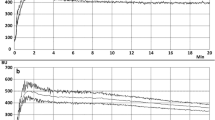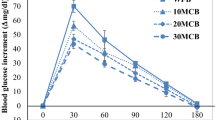Abstract
Resistant starches (RS) are important functional fibers with high potential for the development of healthy foods. The technological, nutritional, and commercial possibilities of introducing type 2 RS in white breads were studied. Four levels of maize RS (HM) as wheat flour replacement were evaluated: 0%, 10%, 20%, and 30% (control, HM10, HM20, and HM30, respectively). Thermal transitions experiments were assessed on doughs prior to breadmaking. The bread quality was studied by specific volume, color of crust and crumb, porosity, and texture of the crumb. The microstructure of the crumb was analyzed by environmental scanning electron microscopy (ESEM). Proximate composition and in vitro starch digestibility were performed to characterize the nutritional profile of breads and estimate the glycemic index (GI). Consumer acceptability of breads was also evaluated. Breads with HM showed great performance up to 20% replacement in the specific volume, the crumb porosity, and the texture. Replacement up to 30% caused major damage to those parameters. Differential scanning calorimetry runs demonstrated that HM starch did not gelatinize under the baking conditions, as confirmed by ESEM. The presence of increasing levels of native starch is thought to have the greatest influence on reducing the crust browning, increasing the crumblier texture and decreasing starch digestibility. With respect to the control, a high and progressive reduction in the estimated GI and an outstanding increase of fiber with increasing levels of HM were found. The sensory evaluation of HM20 bread showed that this level of substitution has great consumer acceptance, giving it the chance to become a healthy substitute of white bread.






Similar content being viewed by others
References
AACC International. (2000). Farinograph method for flour 54-21.01. In AACC International approved methods (pp. 1–7). AACC International.
Ares, G., & Gámbaro, A. (2007). Influence of gender, age and motives underlying food choice on perceived healthiness and willingness to try functional foods. Appetite, 49(1), 148–158. https://doi.org/10.1016/j.appet.2007.01.006.
Armero, E., & Collar, C. (1997). Texture properties of formulated wheat doughs: relationships with dough and bread technological quality. Zeitschrift fur Lebensmittel -Untersuchung und -Forschung, 204(2), 136–145.
Arp, C. G., Correa, M. J., & Ferrero, C. (2018). Rheological and microstructural characterization of wheat dough formulated with high levels of resistant starch. Food and Bioprocess Technology, 11(6), 1149–1163. https://doi.org/10.1007/s11947-018-2083-8.
Arp, C. G., Correa, M. J., Zuleta, Á., & Ferrero, C. (2017). Techno-functional properties of wheat flour-resistant starch mixtures applied to breadmaking. International Journal of Food Science and Technology, 52(2), 550–558. https://doi.org/10.1111/ijfs.13311.
Arvola, A., Lähteenmäki, L., Dean, M., Vassallo, M., Winkelmann, M., Claupein, E., Saba, A., & Shepherd, R. (2007). Consumers’ beliefs about whole and refined grain products in the UK, Italy and Finland. Journal of Cereal Science, 46(3), 197–206. https://doi.org/10.1016/j.jcs.2007.06.001.
Atkinson, F. S., Foster-Powell, K., & Brand-Miller, J. C. (2008). International tables of glycemic index and glycemic load values: 2008. Diabetes Care, 31(12), 2281–2283. https://doi.org/10.2337/dc08-1239.J.B.M.
Augustin, L. S., Franceschi, S., Jenkins, D. J., Kendall, C. W., & La Vecchia, C. (2002). Glycemic index in chronic disease: a review. European Journal of Clinical Nutrition, 56(11), 1049–1071.
Baixauli, R., Sanz, T., Salvador, A., & Fiszman, S. M. (2008). Muffins with resistant starch: baking performance in relation to the rheological properties of the batter. Journal of Cereal Science, 47(3), 502–509. https://doi.org/10.1016/j.jcs.2007.06.015.
Bakke, A., & Vickers, Z. (2007). Consumer liking of refined and whole wheat breads. Journal of Food Science, 72(7), S473–S480. https://doi.org/10.1111/j.1750-3841.2007.00440.x.
Brand-Miller, J. C. (2003). Glycemic load and chronic disease. Nutrition Reviews, 61(suppl_5), S49–S55.
Brouns, F., Bjorck, I., Frayn, K. N., Gibbs, A. L., Lang, V., Slama, G., & Wolever, T. M. S. (2005). Glycaemic index methodology. Nutrition Research Reviews, 18(1), 145–171. https://doi.org/10.1079/NRR2005100.
Burton, P. M., Monro, J. A., Alvarez, L., & Gallagher, E. (2011). Glycemic impact and health: new horizons in white bread formulations. Critical Reviews in Food Science and Nutrition, 51(10), 965–982. https://doi.org/10.1080/10408398.2010.491584.
Carrillo, E., Varela, P., & Fiszman, S. (2012). Effects of food package information and sensory characteristics on the perception of healthiness and the acceptability of enriched biscuits. Food Research International, 48(1), 209–216. https://doi.org/10.1016/j.foodres.2012.03.016.
Cauvain, S. P. (2007). Bread – the product. In S. P. Cauvain & L. S. Young (Eds.), Technology of breadmaking (Second., pp. 1–19). Springer Science+ Business Media, LLC.
Código Alimentario Argentino. (2014).
Dhingra, S., & Jood, S. (2004). Effect of flour blending on functional, baking and organoleptic characteristics of bread, 213–222.
Duţă, D. E., Culeţu, A., & Mohan, G. (2018). 10 - Reutilization of cereal processing by-products in bread making. In C. M. B. T.-S. R. and R. of C. P. B.-P. Galanakis (Ed.), (pp. 279–317). Woodhead Publishing. https://doi.org/10.1016/B978-0-08-102162-0.00010-1.
Evans, I. D. D., & Haisman, D. R. R. (1982). The effect of solutes on the gelatinization temperature range of potato starch. Starch - Stärke, 34(7), 224–231. https://doi.org/10.1002/star.19820340704.
Gargari, B. P., Namazi, N., Khalili, M., Sarmadi, B., Jafarabadi, M. A., & Dehghan, P. (2015). Is there any place for resistant starch, as alimentary prebiotic, for patients with type 2 diabetes? Complementary Therapies in Medicine, 23(6), 810–815. https://doi.org/10.1016/j.ctim.2015.09.005.
Giannone, V., Lauro, M. R., Spina, A., Pasqualone, A., Auditore, L., Puglisi, I., & Puglisi, G. (2016). A novel α-amylase-lipase formulation as anti-staling agent in durum wheat bread. LWT - Food Science and Technology, 65, 381–389. https://doi.org/10.1016/j.lwt.2015.08.020.
Goñi, I., Garcia-Alonso, A., & Saura-Calixto, F. (1997). A starch hydrolysis procedure to estimate glycemic index. Nutrition Research, 17(3), 427–437. https://doi.org/10.1016/S0271-5317(97)00010-9.
Grunert, K. G. (2010). European consumers’ acceptance of functional foods. Annals of the New York Academy of Sciences, 1190(1), 166–173. https://doi.org/10.1111/j.1749-6632.2009.05260.x.
Hidalgo, A., & Brandolini, A. (2011). Evaluation of heat damage, sugars, amylases and colour in breads from einkorn, durum and bread wheat flours. Journal of Cereal Science, 54(1), 90–97. https://doi.org/10.1016/j.jcs.2011.05.002.
Karimi, P., Farhangi, M. A., Sarmadi, B., Gargari, B. P., Zare Javid, A., Pouraghaei, M., & Dehghan, P. (2016). The therapeutic potential of resistant starch in modulation of insulin resistance, endotoxemia, oxidative stress and antioxidant biomarkers in women with type 2 diabetes: a randomized controlled clinical trial. Annals of Nutrition and Metabolism, 68(2), 85–93. https://doi.org/10.1159/000441683.
Kovrlija, R., & Rondeau-Mouro, C. (2017). Hydrothermal changes of starch monitored by combined NMR and DSC methods. Food and Bioprocess Technology, 10(3), 445–461. https://doi.org/10.1007/s11947-016-1832-9.
Martínez, M. M., Román, L., & Gómez, M. (2018). Implications of hydration depletion in the in vitro starch digestibility of white bread crumb and crust. Food Chemistry, 239, 295–303. https://doi.org/10.1016/j.foodchem.2017.06.122
Penn-Marshall, M., Holtzman, G. I., & Barbeau, W. E. (2010). African Americans may have to consume more than 12 grams a day of resistant starch to lower their risk for type 2 diabetes. Journal of Medicinal Food, 13(4), 999–1004. https://doi.org/10.1089/jmf.2009.0195.
Rashidi, A., HadiNezhad, M., Rajabzadeh, N., Yarmand, M. S., & Nemati, S. (2016). Frozen baguette bread dough II. Textural and sensory characteristics of baked product. Journal of Cereal Science, 70, 9–15. https://doi.org/10.1016/j.jcs.2016.05.019.
Rippe, J. M., & Angelopoulos, T. J. (2016). Relationship between added sugars consumption and chronic disease risk factors: current understanding. Nutrients, 8(11), 697. https://doi.org/10.3390/nu8110697.
Salinas, M. V., Zuleta, A., Ronayne, P., & Puppo, M. C. (2016). Wheat bread enriched with organic calcium salts and inulin. A bread quality study. Journal of Food Science and Technology, 53(1), 491–500. https://doi.org/10.1007/s13197-015-2008-8.
Sami, W., Ansari, T., Butt, N. S., & Hamid, M. R. A. (2017). Effect of diet on type 2 diabetes mellitus: a review. International Journal of Health Sciences, 11(2), 65–71.
Sanz, T., Salvador, A., Baixauli, R., & Fiszman, S. M. (2009). Evaluation of four types of resistant starch in muffins. II. Effects in texture, colour and consumer response. European Food Research and Technology, 229(2), 197–204. https://doi.org/10.1007/s00217-009-1040-1.
Acknowledgments
The authors want to thank Ingredion Baradero S.A. for the donation of the Hi-Maize starch for the experiences and Javier Lecot for his kind collaboration on the DSC assays.
Funding
The research was done with funds of the Universidad Nacional de La Plata (project UNLP X661 and X771) and the Agencia Nacional de Promoción Científica y Tecnológica (PICT 2013-0007, PICT 2014-3421).
Author information
Authors and Affiliations
Corresponding author
Rights and permissions
About this article
Cite this article
Arp, C.G., Correa, M.J. & Ferrero, C. High-Amylose Resistant Starch as a Functional Ingredient in Breads: a Technological and Microstructural Approach. Food Bioprocess Technol 11, 2182–2193 (2018). https://doi.org/10.1007/s11947-018-2168-4
Received:
Accepted:
Published:
Issue Date:
DOI: https://doi.org/10.1007/s11947-018-2168-4




